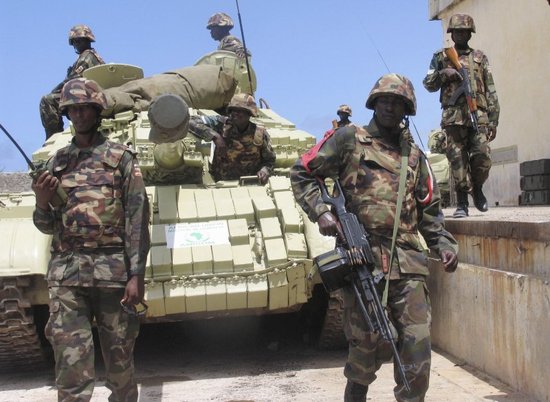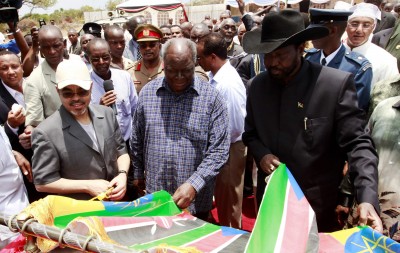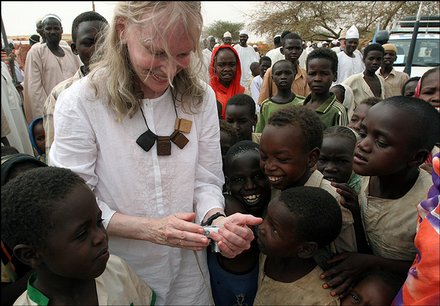By: James Marcus Bridger
As was the case for much of the Cold War, Somalia once again finds itself playing host to a number of competing local, regional, and international actors. The beleaguered Transitional Federal Government (TFG) now controls the capital Mogadishu, thanks to an offensive launched by the African Union Mission in Somalia (AMISOM)—a peacekeeping force composed of Ugandan, Burundian, and Djiboutian troops. Still in control of much of south and central Somalia, however, is the Islamist insurgent group al-Shabaab, whose ranks are swelled by approximately 300 foreign fighters from the Arab world, East Africa, and South Asia. A second front against al-Shabaab was opened in October 2011, when the Kenyan Defence Force (KDF) launched an incursion into southern Somalia. The following month, Ethiopian troops entered the country from the west. AMISOM, the KDF, and Ethiopia have allegedly been assisted in their efforts by the US and France, providing intelligence, satellite imagery, and drone strike capabilities.

Somalia is now receiving more international attention than it has for two decades, but have the results been positive? With a view to the country’s recent history, Robert Pelton of the Somali Report opines that dysfunctional interventions may “plunge Somalia into yet another era of misery.” More optimistically, The Economist speculates that the troubled nation “may now have its best chance of peace and security since 1991.” When attempting to answer this question, it is imperative to examine the interests, progress, and future plans of the intertwined actors.
AMISOM and the TFG
Deployed to Mogadishu in 2007 to protect the newly installed TFG from the resurgent Islamist threat, the AMISOM peacekeeping force was able to secure little more than the presidential palace, airport, and select blocks of the capital for the first four years of its mission. The Ugandan-led force made surprising gains in late 2011, however, when it forced al-Shabaab’s forces to the outskirts of Mogadishu. Buoyed by increased funding from the US and EU, AMISOM has taken on a more offensive “peace-making” mandate. Though many earlier promises had fallen through, 2011 also saw the force receive reinforcing contingents from both Burundi and Djibouti. The African Union (AU) troops recently made their first advance outside of the capital, capturing three Shabaab bases north of Mogadishu.
Despite recent strategic victories, AMISOM still faces a number of limitations. The main problem is underfunding and a lack of personnel. Of the 17,000 troops authorized for the mission, only 10,000 have been deployed. The AU is asking the UN to approve a 50% increase in troop numbers, but where they would come from remains to be seen. Deployments are by no means altruistic. Jeffrey Gettleman of the New York Times notes that contributing nations “vie for influence and use their involvement in the war-ravaged country for leverage with Western aid donors.”

AMISOM’s mandate has also been called into question because of the dubious legitimacy of the TFG. The governing body, formed in Nairobi in 2004, was not elected by the Somali people and has now exceeded its ‘transitional’ mandate. The TFG has becoming increasingly unpopular due to accusations of corruption, rape, looting, and extrajudicial killing. Many Somali residents reported that they felt safer under al-Shabaab’s rule, as the thinly spread AMISOM is not even able to protect them from their own government. Security remains elusive as the Islamists, claiming they made a “tactical withdrawal” from Mogadishu, continue to launch suicide attacks on a near-weekly basis. The UN appears more optimistic about the security situation however, recently deciding to move its special envoy to Somalia office back from Nairobi to Mogadishu after an absence of 17 years.
Kenya
For a rapidly developing country that seeks to establish itself as an East African economic hub, the violent spillover from neighbouring Somalia presents Nairobi with its greatest foreign policy dilemma. Operation “Linda Nchi” (protect the nation) was ostensibly launched as a response to a string of kidnappings conducted by Somali militants in Kenyan territory, though it was later noted that the mission had been planned for months and that the abductions of Western tourists and aid workers had merely served as a “good launch pad,” according to Alfred Mutua, the Kenyan government’s chief spokesman.
Increasingly acting as a link between the resources of East and Central Africa with the markets of Asia, Nairobi intends to build an oil terminal and upgrade the port facilities of Lamu (near the Somali border) in order to connect the unexploited oilfields of South Sudan and northern Kenya to a refining and shipping point on the Indian Ocean. According to an anonymous official however, “Kenya cannot achieve economically what it wants with the situation the way it is in Somalia.” Nairobi’s proposed strategy was to train and equip a contingent of Somali refugees in Kenyan camps in order to establish an autonomous “Jubaland” state in southern Somali that would act as a buffer between the two countries.
Unfortunately for Nairobi, the incipient Jubaland administration was unable to hold back against al-Shabaab, prompting the KDF to deploy approximately 2 000 troops to southern Somalia. Kenya—in conjunction with its local allies, the Raas Kaambooni and Jubaland militias—has succeeded in driving al-Shaabab from a number of border towns, but has been unable to capture the strategic hub of Afmadow or the port of Kismayu, the Islamists’ economic lifeline. The KDF has also launched a campaign of air strikes against al-Shabaab training camps and logistical centres across southern Somalia. While Nairobi claims to have inflicted significant casualties on their insurgent foes, its inexperienced Air Force has been criticized for their indiscriminate bombings which have killed children and refugees.
The East African contends that four major factors have bogged down the Kenyan campaign: a lack of finances for a drawn out war, strategic disagreement over whether to divide Somalia into autonomous regions or maintain a united country, differences over political engagement with al-Shabaab, and an ambivalent relationship with TFG President Sheik Shariff Ahmed. Criticized for its apparent lack of an exit strategy, Nairobi has accepted the African Union’s invitation to integrate its forces into AMISOM, though it remains to be seen how this will be accomplished.
Ethiopia

Predominantly Christian Ethiopia has a long history of animosity with its Muslim neighbour to the east. The two countries went to war in 1977 over the ethnic Somali inhabited Ogaden region of Ethiopia; a conflict which Addis Ababa eventually won with significant Soviet and Cuban patronage. In 2006, US-backed Ethiopian troops invaded Somalia in an attempt to root the governing Islamic Courts Union (ICU) from their seat of power in Mogadishu. Though the capital was turned over to the TFG, hard-line elements of the ICU splintered off to form al-Shabaab, plunging the country into a new chapter of civil war and insurgency.
Withdrawing from the country in 2009, Ethiopian troops returned to Somalia in a surprising November 2011 incursion. While witnesses reported Ethiopian armoured personnel carriers, heavy artillery, and tanks crossing the border into central Somalia, the government in Addis Ababa initially denied that such an operation had taken place. The Ethiopian incursion has thus far been more limited in scope than its Kenyan counterpart. A number of small towns near the Ethiopian-Somali border have been seized from al-Shabaab, the most significant of which was the market city of Beledweyne. Addis Ababa’s favoured strategy, as it was before the 2011 incursion, has been to work through its local allies (or as some have said, proxies), namely the TFG and the Ahlu Sunna Waljamaa (ASWJ) militia.
The timing of the Ethiopian incursion has raised questions about Addis Ababa’s motives and preferred outcome in Somalia. Al-Shabaab is a common enemy of AMISOM, the TFG, Kenya and Ethiopia, so there was obvious strategic merit in opening up a third front against the Islamists when they appeared to be at their weakest point in years. That being said, Addis Ababa also has a national interest in strengthening the position of its local allies in the inevitable vacuum that would follow the Shabaab’s defeat. Fearful of irredentist claims to the Ogaden region, Ethiopia has a long history of backing multiple horses in the Somali power struggle (including the autonomous states of Somaliland and Puntland, as well as the TFG and ASWJ) in order to prevent the re-emergence of a strong centralized state. Despite good relations between Addis Ababa and Nairobi, observers have noted that Ethiopia does not want Kenya to have a free hand in shaping a political settlement in central and south Somalia. Given that it continues to combat its own Ogadeni rebellion, Addis Ababa is against the idea of an Ogadeni-dominated autonomous state being established in Jubaland.
As for its future plans, Ethiopia appears to have learned from its previous invasion and is not keen to overstay its welcome in Somalia. The country has decided not to join the AMISOM force and Addis Ababa claims that its troops will soon leave central Somalia, turning over captured towns to the TFG and allied militias. It is not yet clear that al-Shabaab has been weakened enough to warrant an Ethiopian withdrawal however. On 23 January, the Islamists were able to detonate a truck bomb outside of an Ethiopian military base in Beledweyne, reportedly killing 10 soldiers.
The US
Given that ongoing insecurity has spawned an international piracy crisis and allowed the country to become a haven for al-Qaeda, the US and its allies have a vested interest in a stable Somalia. Both NATO and the EU have provided logistical and financial support to AMISOM and continue to engage in counter-piracy patrols. Aside from the obvious warships stationed off the Horn of Africa, Washington has attempted to keep a hidden footprint in its most recent Somali operations—ever mindful of the 18 US Rangers killed during the 1993 “Black Hawk Down” disaster. In what has been described as a “proxy fight” against al-Shabaab, the US has spent more than $500 million to equip and train East Africa militaries since 2007.
The US claimed it was unaware of Kenya’s planned incursion, though many have doubted this, given that Nairobi functions as Washington’s primary counter-terrorism intelligence gathering hub in the region. It was further revealed via Wikileaks cables that the Kenyan foreign ministry had attempted to garner US support for Nairobi’s Jubaland initiative several times over the past year and that they likely tailored the operational planning of their incursion to meet US and Ethiopian concerns.

In October 2011, the US began secretly flying heavily armoured Reaper drones from an airfield in southern Ethiopia, a move described as an escalation of the covert war being fought against al-Shabaab and its al-Qaeda affiliates. The exact role that US drones are playing in Somalia remains shrouded in secrecy. Major Emmanuel Chirchir, the spokesman for the KDF, claims that “one of [Kenya’s] partners” had been behind a number of airstrikes against Shabaab positions in southern Somalia—a role that the Kenyan military has attributed to both American drones and the French Navy. Officials from both Washington and Paris have denied responsibility and suggested that it might be the other. What is known for sure, according to Lauren Gelfand of Jane’s Defense Weekly, is that a number of strikes have demonstrated a capability and accuracy that is beyond that of AMISOM or the KDF. Military sources speaking to the Somalia Report allege that Kenyan flybys are being used as a cover for far more accurate US drone strikes.
An anonymous official in Washington uncharacteristically confirmed that the US was responsible for a drone strike that killed a British-raised al-Qaida leader, Bilal al-Berjawi, just south of Mogadishu on 21 January.
In terms of a forward thinking plan for Somalia, Johnnie Carson, US Assistant Secretary for the Bureau of African Affairs, has vocally urged both Kenya and Ethiopia to strengthen AMISOM; further noting that military action from any one state alone can neither bring down al-Shabaab nor improve the situation in Somalia. However, this Mogadishu and TFG centric approach favoured by the US State Department suffers from the aforementioned loss of legitimacy faced by the country’s “federal government.” The Pentagon and CIA, for their part, prefer a “building block” strategy that seeks to engage and develop Somalia’s autonomous units.
Looking Forward
The security situation in Somalia is an incredibly complex and ever-changing picture. The troops of five regional states—aided actively by the US and possibly France—are locked in combat with an indigenous Islamist insurgency that has become a focal point of the global jihadist movement. With al-Shabaab on the back foot, Somalia is now at a cross-road. Having explored the interests, strategy, and progress of the various actors, Part II of “A Somali Quagmire” will examine the prospects and pitfalls that the country now faces.
Disclaimer: Any views or opinions expressed in this article are solely those of the authors and the news agencies and do not necessarily represent those of the NATO Council of Canada. This article is published for information purposes only.




